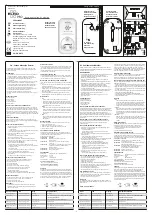
7.2 Chronic effects on high risk groups
Individuals with coronary artery disease exposed to
low levels of CO show reduced ability to exercise
and the time of onset of exercise-induced angina
pectoris in such patients exposed to low levels of CO
is reduced.
Carbon monoxide readily crosses the placental
barrier and may endanger the normal development of
the foetus.
A number of high-risk groups are particularly
sensitive to the effects of CO because of various
organ impairments or specific changes, mainly:
a) those whose oxygen carrying capacity is
decreased due to anaemia or other haemoglobin
disorders;
b) those with increased oxygen needs such as those
encountered in fever, hyperthyroidism or pregnancy;
c) those with systemic hypoxia due to respiratory
insufficiency;
d) those with heart disease and any vascular
insufficiency.
WHO guidance states that in order to protect non-
smoking, middle-aged and elderly population groups
with documented or latent coronary artery disease
from acute ischaemic heart attacks, and to protect
the foetuses of non-smoking pregnant women from
untoward hypoxic effects, a COHb level of 2.5%
should not be exceeded. The following WHO
guideline values and periods of time-weighted
average exposures have been determined in such a
way that the COHb level of 2.5% is not exceeded,
even when a normal subject engages in light or
moderate exercise:
• 100 mg/m³ (90 ppm) for 15 min;
• 60 mg/m³ (50 ppm) for 30 min;
• 30 mg/m³ (25 ppm) for 1 h;
• 10 mg/m³ (10 ppm) for 8 h.
7.3 Normal COHb levels
Under normal conditions, humans typically have low
levels of COHb of between 0.3% and 0.7% present
within the body. These levels are considered neither
beneficial nor harmful.
7.4 Tobacco smoking
Tobacco smokers are exposed to significant
concentrations of CO. In cigarette smokers, the
COHb concentration varies between 5%-9%, while
heavy cigar smokers may exceed 10%.
WARNING!-
Exposure to high levels of
carbon monoxide can be fatal or cause permanent
damage and disabilities.
WARNING!-
The device may not prevent
the chronic effects of carbon monoxide exposure
and that the device will not fully safeguard
individuals at special risk.
8. Battery information
8.1 Battery type
This device is powered by a sealed-in Lithium-ion
battery system. The battery type is CR17450.
Once activated, the battery will supply power to the
alarm for 10 years under normal operation
conditions.
NOTE: No battery installation or replacement is
necessary for the life of the device.
NOTE: Constant exposure to high or low humidity
may reduce battery life.
8.2 Battery activation
This device is equipped with a feature that
automatically activates the alarm when the alarm is
attached to the mounting plate for the first time.
NOTE: This device MUST be installed on the
matching bracket, otherwise the device won't
work.
8.3 Battery deactivation
This device is equipped with low battery monitor
circuit which will cause the alarm to produce chirps
once and blink the FAULT indicator (yellow) every
40 seconds. you must to replace the device within 7
days of the first occurrence of the "Low battery
warning" to provide continuous alarm protection..
The device must be deactivated prior to disposing,
please see "
10. Deactivation of the device
".
8.4 Battery disposal
WARNING!-
Fire, explosion and severe burn
11
/
14
GS883-A Instruction Manual Rev. G
































